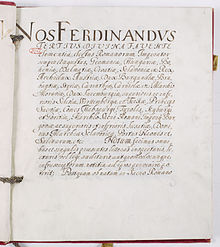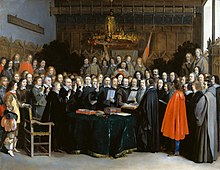Treaty of Münster (October 1648)


The Treaty of Münster of 24 October 1648[1] was a treaty signed in Münster between, on the one hand, the Kingdom of France with regent cardinal Jules Mazarin for the underage king Louis XIV of France, plus his allies, and, on the other hand, Holy Roman Emperor Ferdinand III and his allies.
Background[edit]
The treaty was part of the Peace of Westphalia, which ended the Thirty Years' War (1618–1648) and the Eighty Years' War (c. 1566–1648).[1]
- Peace of Münster (30 January 1648), which ended the Eighty Years' War between the Spanish Empire and the Dutch Republic.[1]
- Treaty of Münster (24 October 1648), which ended the war between France and the Holy Roman Empire (since 1635).[1]
- Treaty of Osnabrück (24 October 1648), which ended the war between Sweden and the Holy Roman Empire (since 1630).[1]
Contents[edit]

The treaty consists of a main act and two annexes.[2] The main act is the peace treaty itself.[2] The first annex is the act of cession to the King of France of the Three Bishoprics, Alsace, Brisach and Pignerol; the second is the act of cession of Alsace to the King of France.
This treaty took a long time to materialise. Indeed, the negotiations started on 25 December 1641, but the signatures were not formalised until seven years later. This delay was due to some delicate issues – including the structure of the Empire – on which the authorities did not agree.
References[edit]
Bibliography[edit]
- Duparc, Pierre (1948). "Les actes du traité de Münster de 1648 entre la France et l'Empire" (fac-similé). Bibliothèque de l'École des chartes8 (in French). 107 (1): 5261. doi:10.3406/bec.1948.449379. Retrieved 10 February 2018.
